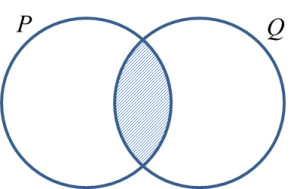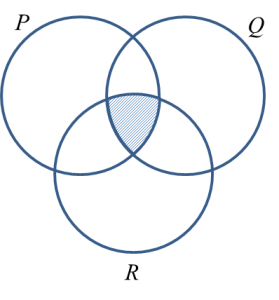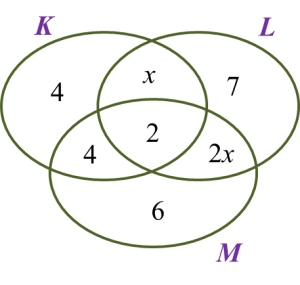4.3 Operations on Statements
Example 3:
Solution:
Solution:
3.4 SPM Practice (Long Questions)
(a) The Venn diagrams in the answer space shows sets P and Q such that the universal set, ξ = P υ Q.
Shade the set P ∩ Q.
(b) The Venn diagrams in the answer space shows sets X and Y and Z, such that the universal set, ξ = X υ Y υ Z.
Shade the set (X υ Z) ∩ Y.
Solution:
(a)
• P ∩ Q means the intersection of the region P and the region Q.
(b)
• (X υ Z) means the union of the region X and the region Z.
• The region then intersects with region Y to give the result (X υ Z) ∩ Y.
3.1 Set
Example:
6. A dot to the left of an object in a Venn diagram indicates that the object is an element of the set.
7. When a Venn diagram represents the number of elements in a set, no dot is placed to the left of the number.
3.2 Subset, Universal Set and the Complement of a Set
Example 1:
2. The Venn diagram below shows the relationship between B, B’ and the universal set, ξ.
The complement of set B is represented by the green colour shaded region inside the universal set, ξ, but outside set B.
3.3 Operations on Sets (Part 1)
2. The intersection of set P, set Q and set R, denoted by P∩Q∩R is the set consisting of all elements common to set P, set Q and set R.
3. Represent the intersection of sets using Venn diagrams.
(a) P ∩ Q



(d) P ∩ Q ∩ R

3.2 Subset, Universal Set and the Complement of a Set
2. The symbol ⊂ is used to denote ‘is a subset of’.
Therefore A⊂B.
3. A⊂B. can be illustrated using Venn diagram as below:
3.2 Subset, Universal Set and the Complement of a Set
Example:
Solution:
(b)(ii)
3.4 SPM Practice (Short Questions)
Question 1:
List all the subsets of set P = {r, s}.
Solution:
There are 2 elements, so the number of subsets of set P is 2n = 22 = 4.
Set P = {r, s}
Therefore subsets of set P = {r}, {s}, {r, s}, {}
Question 2:
Diagram above shows a Venn diagram with the universal set, ξ = Q ∪ P. List all the subset of set P.
Solution:
Set P has 3 elements, so the number of subsets of set P is 2n = 23 = 8.
Set P = {2, 3, 5}
Therefore subsets of set P = {}, {2}, {3}, {5}, {2, 3}, {2, 5}, {3, 5}, {2, 3, 5}.
Question 3:
It is given that the universal set, ξ = {x : 30 ≤ x < 42, x is an integer} and set P = {x : x is a number such that the sum of it its two digits is an even number}.
Find set P’.
Solution:
ξ = {30, 31, 32, 33, 34, 35, 36, 37, 38, 39, 40, 41}
P = {31, 33, 35, 37, 39, 40}
Therefore P’ = {30, 32, 34, 36, 38, 41}
Question 4:
Given that universal set ξ = {x : 3 < x ≤ 16, x is an integer},
Set A = {4, 11, 13, 16},
Set B = {x : x is an odd number} and
Set C = {x : x is a multiple of 3}.
The elements of the set (A ∪ C)’ ∩ B are
Solution:
ξ = {4, 5, 6, 7, 8, 9, 10, 11, 12, 13, 14, 15, 16}
A = {4, 11, 13, 16}
B = {5, 7, 9, 11, 13, 15}
C = {6, 9, 12, 15}
(A∪C)' = {5, 6, 7, 8, 10, 14}
Therefore (A∪C)’ ∩ B = {5, 7}
3.4 SPM Practice (Short Questions)
Question 5:
Diagram below shows a Venn diagram with the number of elements of set P, set Q and set R.

Solution:
Question 6:

If the number of participants who participate in only one quiz is 76, find the total number of the participants.
Solution:
8x = 64
x = 8
Question 7:

If the number of students who join both the Life Guards Club and the Martial Arts Club is 8, find the number of students who join only two clubs.
Solution:












